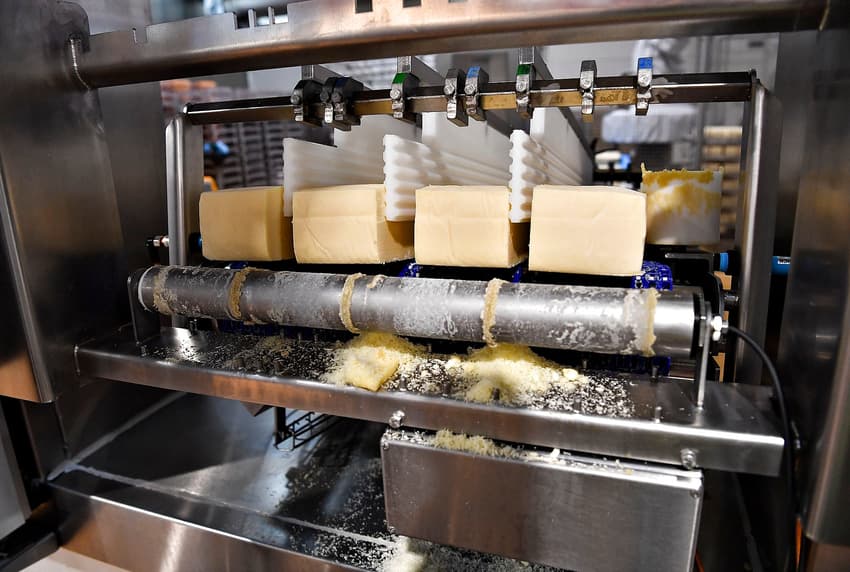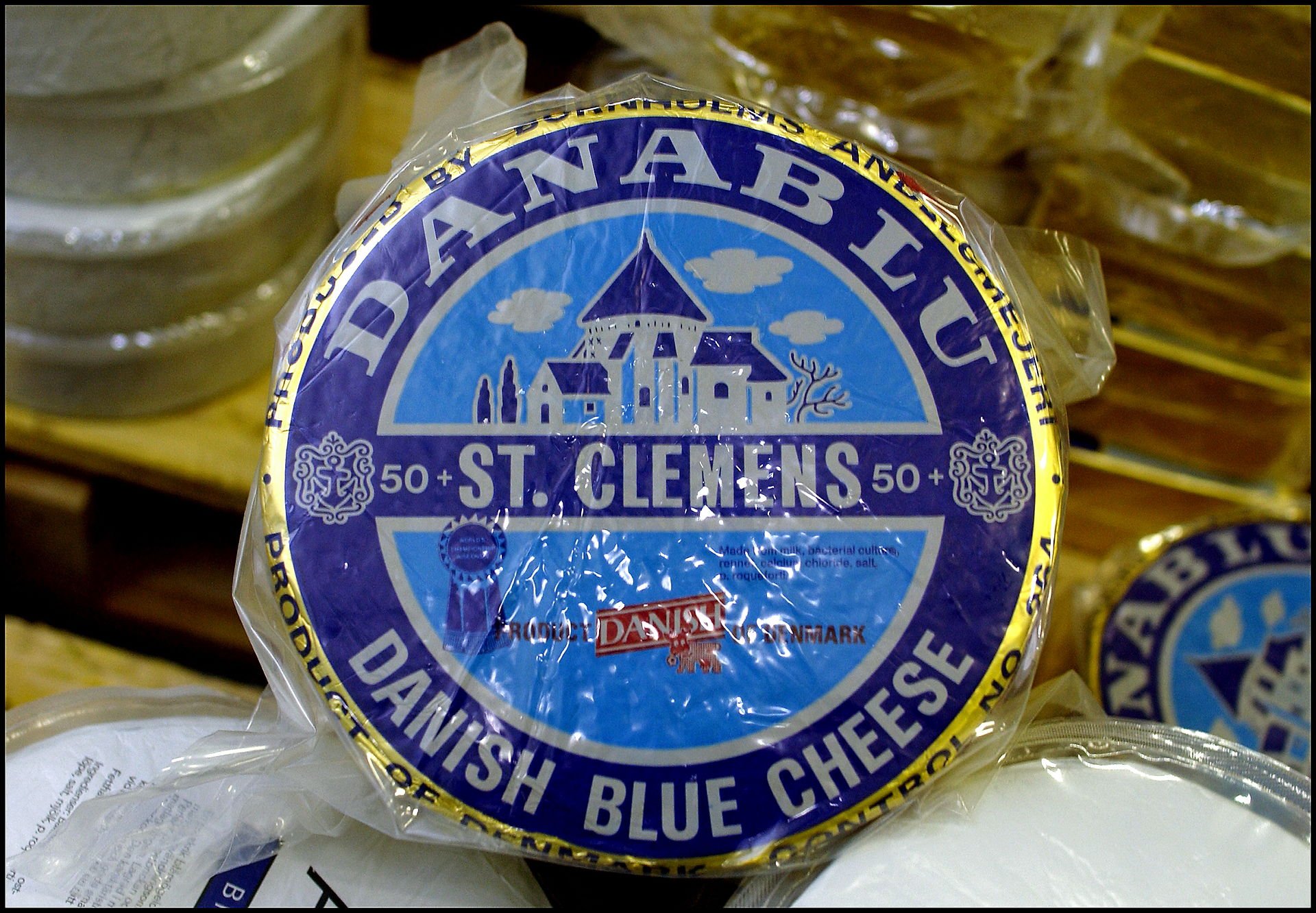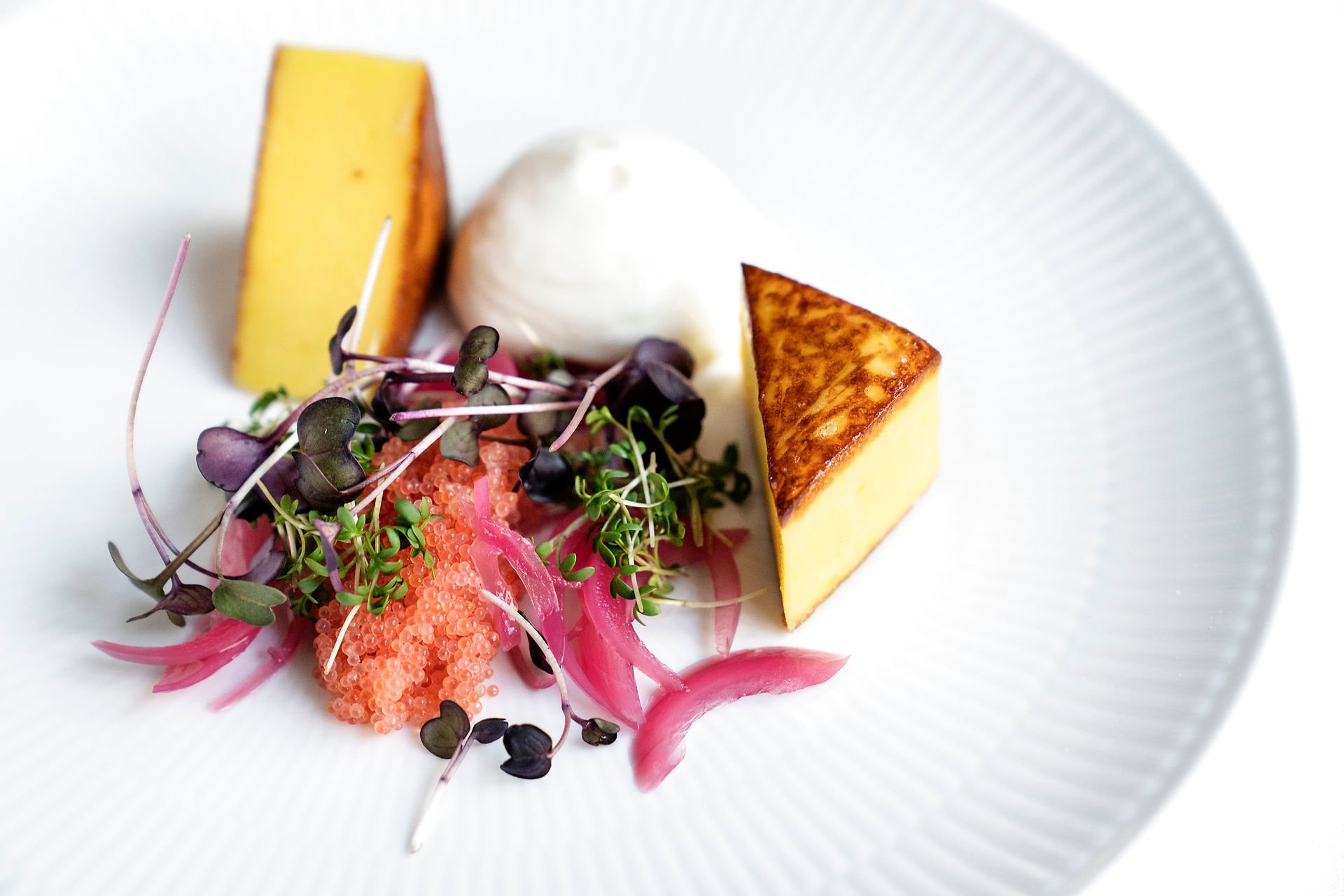Why does Denmark produce so much cheese?

From Danbo to Danablu and the Danish feta that can't be called feta - Denmark produces over four hundred thousand tonnes of cheese each year and exports it across the world. So why is Danish cheese so popular, and what are the country's best-loved cheeses?
Cheese-making is a serious business in Denmark. In 2021, the country produced a total of 454,500 tonnes of cheese and Danish cheese has won awards at the World Championship Cheese Contest.
The tradition goes back to the Viking era and today, the country's climate and pastoral land make it ideal for producing cheese (ost). About three quarters of the country's milk production is turned into cheese, butter and milk powder.
Not only is cheese popular in Denmark, where it's eaten with pretty much any meal and snack (can you even have a bolle [bread roll] without ost?), it is also eaten around the world in countries including South Korea, New Zealand, Canada, Nigeria and even France.
In 2021, Denmark exported a total of 401,845 tonnes of cheese, making it one of the top cheese exporters in the world. The biggest importer of Danish cheese was Germany (94,419 tonnes), followed by Sweden (52.924 tonnes) and the UK (42,905 tonnes). 18,097 tonnes of cheese was exported to Japan and 5,657 to the United States.
What types of cheese does Denmark make?
The different types of cheese in Denmark can be hard to distinguish and there are a lot of them. You can quite easily end up with a fridge full of strong smells that you weren't expecting.
Danbo, often called 'Denmark's national cheese', is the most produced and consumed cheese in Denmark. It has Protected Geographical Indication (PGI) status, meaning it can only be made in Denmark to specific Danish standards.
Danbo is sold under various trade and brand names, including Lillebror, Gamle Ole, and Riberhus. Lillebror (meaning Little brother) is very mild and often sold in childrens' packs, whereas Gamle Ole (meaning Old Ole) is matured for a long time, which means it's strong and smelly. Caraway seeds are sometimes added to this cheese.
Esrom also has Protected Geographical Indication (PGI) status and is made from pasteurised cow’s milk. It is semi-soft with small holes and is pretty pungent.
Havarti is one of the most famous Danish cheeses. It's a bit like a cheddar in that the taste can be mild, but the longer the cheese is stored, the stronger it gets.
Danablu is a Danish Blue soft blue cheese, similar to Roquefort. It has a strong aroma and a sharp and a little salty taste. Danablu is often used in America to make blue cheese dressing for salads and blue cheese dip for chicken wings.

A dairy farm in Klemensker, Bornholm has twice been named world champion in cheese making. Photo: Morten Juhl/Ritzau Scanpix
Mycella is a veined blue cheese made from pasteurised cow’s milk on the island of Bornholm and is similar to Gorgonzola. It goes well in a salad or cheese platter or even crumbled on top of an open sandwich.
Blå kornblomst, meaning 'blue cornflower', is a creamy blue cheese with a mild, slightly salty taste. The cheese is white to yellowish with blue tinges and is made from pasteurised cow's milk on North Jutland.
Danish rygeost, meaning 'smoked cheese' is mild, light and smokey. It originates from 19th century Funen, with some believing it dates back to the Viking Age.

A dish of potato, monkfish and smoked cheese. Photo: Thomas Lekfeldt/Ritzau Scanpix
Vesterhavsost, meaning 'North Sea Cheese', is a semi-hard cheese with a slightly salty taste as it is ripened in the sea air of North Jutland. It's referred to as the Danish version of Gouda.
Fyrmester or Fyrtårnsost, meaning 'The Lighthouse Keeper' or 'Lighthouse Cheese', is an extra-mature version of the vesterhavsost, aged for at least 52 weeks.
Samsø cheese is similar to Emmentale and made on the island of Samsø in Kattegat.
Hvid ost, meaning 'white cheese', is Denmark's equivalent to feta cheese but uses cow's milk rather than the goat or sheep's milk used in Greek feta cheese. It's milder and doesn't crumble like Greek feta cheese because it's made differently, using something called ultrafiltration.
There have been debates as to whether this actually makes it feta cheese. Earlier this year, Denmark lost a case at the European Court of Justice over its farmers exporting cheese outside the EU labelled feta, something only Greece can do. The cheese is sometimes labelled in supermarkets as 'salad cubes' (salat-tern).
There is, perhaps, one thing that unites almost all Danish cheeses: they are sliced using the characteristic ostehøvl (cheese slicer), the quintessential Danish kitchen utensil.
There are two types of ostehøvl: a wire-based type and a version that looks a bit like a trowel, with a raised edge and a gap in the middle for the sliced cheese to pass through.
Cheese vocab:
Blød ost: Soft cheese
Halvfast ost: Semi-soft cheese
Fast ost: Semi-hard cheese
Hård ost: Hard cheese
Ekstra hård ost: Extra hard cheese
Frisk ost: Fresh cheese
Ostehøvl: cheese slicer
Comments
See Also
Cheese-making is a serious business in Denmark. In 2021, the country produced a total of 454,500 tonnes of cheese and Danish cheese has won awards at the World Championship Cheese Contest.
The tradition goes back to the Viking era and today, the country's climate and pastoral land make it ideal for producing cheese (ost). About three quarters of the country's milk production is turned into cheese, butter and milk powder.
Not only is cheese popular in Denmark, where it's eaten with pretty much any meal and snack (can you even have a bolle [bread roll] without ost?), it is also eaten around the world in countries including South Korea, New Zealand, Canada, Nigeria and even France.
In 2021, Denmark exported a total of 401,845 tonnes of cheese, making it one of the top cheese exporters in the world. The biggest importer of Danish cheese was Germany (94,419 tonnes), followed by Sweden (52.924 tonnes) and the UK (42,905 tonnes). 18,097 tonnes of cheese was exported to Japan and 5,657 to the United States.
What types of cheese does Denmark make?
The different types of cheese in Denmark can be hard to distinguish and there are a lot of them. You can quite easily end up with a fridge full of strong smells that you weren't expecting.
Danbo, often called 'Denmark's national cheese', is the most produced and consumed cheese in Denmark. It has Protected Geographical Indication (PGI) status, meaning it can only be made in Denmark to specific Danish standards.
Danbo is sold under various trade and brand names, including Lillebror, Gamle Ole, and Riberhus. Lillebror (meaning Little brother) is very mild and often sold in childrens' packs, whereas Gamle Ole (meaning Old Ole) is matured for a long time, which means it's strong and smelly. Caraway seeds are sometimes added to this cheese.
Esrom also has Protected Geographical Indication (PGI) status and is made from pasteurised cow’s milk. It is semi-soft with small holes and is pretty pungent.
Havarti is one of the most famous Danish cheeses. It's a bit like a cheddar in that the taste can be mild, but the longer the cheese is stored, the stronger it gets.
Danablu is a Danish Blue soft blue cheese, similar to Roquefort. It has a strong aroma and a sharp and a little salty taste. Danablu is often used in America to make blue cheese dressing for salads and blue cheese dip for chicken wings.

Mycella is a veined blue cheese made from pasteurised cow’s milk on the island of Bornholm and is similar to Gorgonzola. It goes well in a salad or cheese platter or even crumbled on top of an open sandwich.
Blå kornblomst, meaning 'blue cornflower', is a creamy blue cheese with a mild, slightly salty taste. The cheese is white to yellowish with blue tinges and is made from pasteurised cow's milk on North Jutland.
Danish rygeost, meaning 'smoked cheese' is mild, light and smokey. It originates from 19th century Funen, with some believing it dates back to the Viking Age.

Vesterhavsost, meaning 'North Sea Cheese', is a semi-hard cheese with a slightly salty taste as it is ripened in the sea air of North Jutland. It's referred to as the Danish version of Gouda.
Fyrmester or Fyrtårnsost, meaning 'The Lighthouse Keeper' or 'Lighthouse Cheese', is an extra-mature version of the vesterhavsost, aged for at least 52 weeks.
Samsø cheese is similar to Emmentale and made on the island of Samsø in Kattegat.
Hvid ost, meaning 'white cheese', is Denmark's equivalent to feta cheese but uses cow's milk rather than the goat or sheep's milk used in Greek feta cheese. It's milder and doesn't crumble like Greek feta cheese because it's made differently, using something called ultrafiltration.
There have been debates as to whether this actually makes it feta cheese. Earlier this year, Denmark lost a case at the European Court of Justice over its farmers exporting cheese outside the EU labelled feta, something only Greece can do. The cheese is sometimes labelled in supermarkets as 'salad cubes' (salat-tern).
There is, perhaps, one thing that unites almost all Danish cheeses: they are sliced using the characteristic ostehøvl (cheese slicer), the quintessential Danish kitchen utensil.
There are two types of ostehøvl: a wire-based type and a version that looks a bit like a trowel, with a raised edge and a gap in the middle for the sliced cheese to pass through.
Cheese vocab:
Blød ost: Soft cheese
Halvfast ost: Semi-soft cheese
Fast ost: Semi-hard cheese
Hård ost: Hard cheese
Ekstra hård ost: Extra hard cheese
Frisk ost: Fresh cheese
Ostehøvl: cheese slicer
Join the conversation in our comments section below. Share your own views and experience and if you have a question or suggestion for our journalists then email us at [email protected].
Please keep comments civil, constructive and on topic – and make sure to read our terms of use before getting involved.
Please log in here to leave a comment.